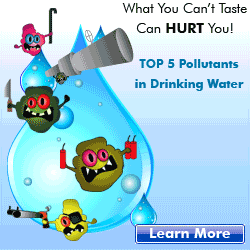
- The TRUTH About America's Water
- Water Pollutants that Cause Illness
- Are Minerals in Water Important for Health?
- Top 5 Drinking Water Contaminants
- Do I Need a Whole House Water Filter?
PUBLIC DRINKING WATER UTILITIES do limited testing at customers' taps with most of their analyses performed on treated water prior to its entry into the distribution system.

Does simple monitoring of finished water at the treatment plant guarantee good water quality at the tap?
Not always because a number of process changes in water treatment techniques, including modified chlorination procedures, which generally provides excellent water quality at the treatment plant before it enters a distribution system, can cause changes within the distribution system that negatively impacts water quality at customers’ taps.
For example, flow changes or water chemistry changes that can either cause erosion or corrosion of toxic element-containing scales, which have built up over years, can result in toxic levels of lead or arsenic being delivered to consumers’ taps.
The presence of contaminants does not necessarily indicate that water poses a health risk. More information about contaminants and potential health effects can be obtained by calling the Environmental Protection Agency's (EPA) Safe Drinking Water Hotline (800-426-4791). Contaminants that may be present in source water include:
- Microbial contaminants, such as viruses and bacteria, which may come from sewage treatment plants, septic systems, agricultural livestock operations, and wildlife.
- Inorganic contaminants, such as salts and metals, which can be naturally-occurring or result from urban storm water runoff, industrial or domestic wastewater discharges, oil and gas production, mining, or farming.
- Pesticides and herbicides, which may come from a variety of sources such as agriculture, urban storm water runoff, and residential uses.
- Organic chemical contaminants, including synthetic and volatile organics, which are by-products of industrial processes and petroleum production, and can also come from gas stations, urban storm water runoff and septic systems.
- Radioactive contaminants, which can be naturally occurring or be the result of oil and gas production and mining activities.
There are many tests run at the water treatment plant before treatment is done on the water, and as it is being treated at many different stages. This enables the water treatment operator the opportunity to gather data and make correct changes in the treatment process to better produce a safer and better tasting product. An example of the several tests run include:
|
|
|
|
|
|
|
|
|
|
|
|
|
|
|
|
|
|
|
|
While these assessments are some basic tests run to ensure optimum water quality, water utilities still must perform quality assessment closer to the taps of the drinking water public. Therefore, it is important that water utilities do selected flushing, scale analysis or even random tap water analysis for their system when significant changes are made in water flow or water treatment, especially chlorination treatment procedures. Such activities may cause release of accumulated elements from iron-containing scales or pipe films.
The sources of drinking water (both tap water and bottled water) include rivers, lakes, streams, ponds, reservoirs, springs, and wells. Our water comes from surface waters. As water travels over the surface of the land or through the ground, it dissolves naturally-occurring minerals and, in some cases, radioactive material, and can pick up substances resulting from the presence of animals or from human activity. Drinking water, including bottled water, may reasonably be expected to contain at least small amounts of some contaminants.

